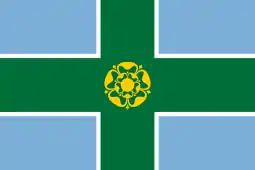Codnor Castle
Codnor Castle is a ruined 13th-century castle in Derbyshire, England. The land around Codnor came under the jurisdiction of William Peverel after the Norman conquest.[1] Although registered as a Scheduled Ancient Monument[2] and Grade II Listed Building[3] the site is officially, as at 2016, a Building at Risk.[4]
| Codnor Castle | |
|---|---|
| Aldercar and Langley Mill, Amber Valley, Derbyshire | |
 Remains of Codnor Castle, viewed from the north-west | |
 Codnor Castle | |
| Coordinates | 53°02′43″N 1°21′17″W |
| Site information | |
| Condition | Ruined |
| Site history | |
| Built | 13th century |
| Materials | stone |
| Official name | Codnor Castle |
| Reference no. | 1007047 |
Listed Building – Grade II | |
| Official name | Remains of Codnor Castle, Castle Lane |
| Designated | 25 November 1963 |
| Reference no. | 1109025 |
| Managed by | The Codnor Castle Heritage Trust |
| Website | http://www.codnorcastle.co.uk/ |
History
William Peverel
The castle is a stone keep and bailey fortress and was established by William Peverel. The present fragmentary remains represent a three-storey keep and a strong curtain wall and ditch, flanked by round towers. The outer bailey is on a lower level and was constructed at a later period. The castle overlooks the Erewash valley and the counties of Derbyshire and Nottinghamshire. It originally had a deep moat and on its eastern side there was once a considerable abundance of trees, which have now been cut down. On the west side there was a courtyard that was strongly fortified by huge round towers, which had battlements. In other parts of the ruins there is evidence that the outer walls had arrow-loops included to allow bowmen to use them if necessary.
Henry de Grey
By 1211 it was owned by Henry de Grey, a descendant of the Norman knight Anchetil de Greye. Henry's descendants include the long line of Lords Grey of Codnor, the Lords Grey of Ruthyn, Wilton and Rotherfield, Lady Jane Grey and the Earls of Stamford, and the extinct families of the Dukes of Suffolk and Kent. His son Richard settled in Codnor and was a loyal Baron to Henry III. Along with his brother John they served the King in the Holy Land. John Grey distinguished himself in the Scottish wars and found himself in great favour with Edward III. Together with William D'Eincourt,[5] the Lord Grey commanded all the knights of Derbyshire and Nottinghamshire in case of an invasion. Henry, the last of the family, died during the reign of Henry VII without a legitimate heir. He left part of his lands to his illegitimate sons, Henry and Richard, and part to his widow, Katherine Stourton.
Zouche family
The remainder went to his aunt Elizabeth Grey, who in 1429 married Sir John Zouche, the youngest son of the fourth Baron Zouche of Harringworth. Sir John Zouche of Codnor was three times High Sheriff of Derbyshire. The castle remained in the hands of the Zouche family for two hundred years until they sold up and emigrated to Virginia in 1634.
Streynsham Master
Sir Streynsham Master, High Sheriff of Derbyshire, who bought the Codnor Castle estate in 1692, is reported as the last resident of the castle. He lived there until his death in 1724.
Preservation

Today the remnants of Codnor Castle are a fragile ruin; its few remaining high walls are well visited. The site is now privately owned. Public access is managed by The Codnor Castle Heritage Trust; access can be arranged by contacting the Trust.
There are public footpaths to the Castle from Codnor Market Place, where there is an information board in partnership with Derbyshire County Council, as well as public footpaths from the east in the Erewash valley.
In June 2007, Channel 4's Time Team programme carried out an archaeological dig around the castle. A perfectly preserved gold noble of Henry V was found in the moat and is now displayed at Derby Museum and Art Gallery.[6]
Most Haunted Live! visited the castle as part of a paranormal investigation 'As Live' special in 2017. The programme was broadcast in March 2018.[7]
References
- Codnor – the Domesday Book Online Archived 26 September 2007 at the Wayback Machine accessed 6 January 2008
- Historic England. "Codnor Castle (1007047)". National Heritage List for England. Retrieved 15 February 2014.
- Historic England. "Remains of Codnor Castle (Grade II) (1109025)". National Heritage List for England. Retrieved 15 February 2014.
- "Heritage at Risk - East Midlands Register 2016". Historic England. 2016. Archived from the original on 20 December 2016. Retrieved 7 December 2016.
A major repair works programme was completed in 2008. The Codnor Castle Heritage Trust is carrying out maintenance works and running public events with the landowner's permission. The Lower Court east wall is in danger of collapse and has been temporarily supported. The long-term management of the site has yet to be fully resolved, but proposals are being discussed.
- William D'Eincourt was the son of Walter D'Eincourt, who held "sixty-seven lordships", of which Blankney was his "principal seat." – sourced from this book extract
- Time Team at Channel Four: Codnor Castle, first broadcast 6 January 2008, accessed 4 July 2008
- "Most Haunted at Codnor Castle Cottage – 2018 Special Review". HiggyPop. 2 March 2018. Retrieved 3 May 2018.
External links
| Wikimedia Commons has media related to Codnor Castle. |
- Codnor Castle – official website
- Heanor & District Local History Society covers the Codnor area, and their site contains a page (with photographs) of the castle
- Codnor & District Local History & Heritage website – Codnor Castle webpage
- "Time Team arrives at Codnor Castle" – Ripley & Heanor News (14 June 2007)
- Earthwork Analysis English Heritage Research Reports (contains maps)
- Archaeological Evaluation and Assessment of Results report by Wessex Archaeology on Time Team dig
- Heritage at Risk Register: Codnor+Castle
